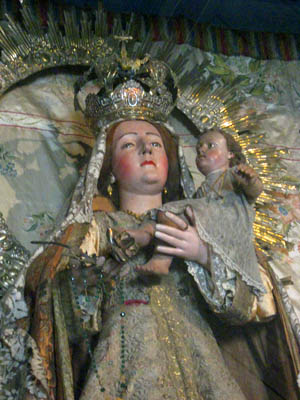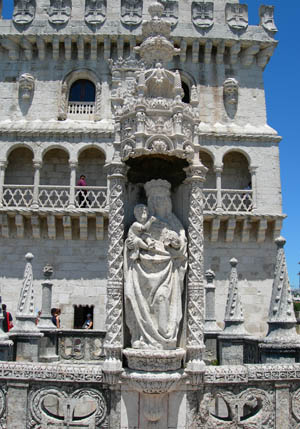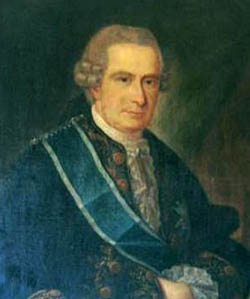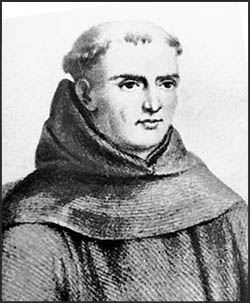Recently, this interesting letter came from a reader in California to the TIA correspondence desk:

Nuestra Señora de Belén
San Carlos Borromeo Mission
|
Is the statue of Our Lady of Bethlehem in the Carmel Mission connected to the devotion of Our Lady of Good Success? I read on your site that the original statue of Our Lady of Good Success was in Spain and that the devotion to that image spread quickly throughout Europe. I ask because the two statues look so similar.
As you probably know, the statue of Our Lady of Bethlehem was brought to Carmel by Fr. Serra to stop the Russian invasion that was threatening the Pacific Coast. Do you have any more information on that historic statue? It is difficult to find anything on this topic.
All the best to you and thank you for your wonderful site!
Sincerely,
D.L.

The story of the beautiful statue of Nuestra Señora de Belén [Our Lady of Bethlehem] is one of the buried histories of our Catholic past. Like the Missions themselves that were abandoned and left to decay and then fortunately restored in the 19th century, historic facts like those related to this devotion should be resurrected and given a place of prominence in Catholic textbooks. It is to encourage this initiative that I write this article.
First let us look at the Portuguese roots of this devotion, and then follow Our Lady of Bethlehem’s journey to the Mission of Carmel in Upper California.
Portuguese roots
The title Our Lady of Bethlehem honors Our Lady at the birth of Christ. The Marian calendar celebrates the feast the Virgin of Bethlehem at Christmas, the Nativity of Our Lord. This devotion became popular in the 15th century in Portugal and Spain during the Age of Discovery because of the Portuguese Chapel to the Virgin of Belén, or Virgin of Restelo, in the Belem Tower close to Lisbon, the point of departure for ships seeking the route to India.

A copy of the Chapel's statue was placed outside Belen Tower |
In the Tower a small chapel was built by the Infante Don Henry the Navigator and dedicated to Our Lady of Bethlehem. The sailors would go to pray before the stone statue of Our Lady seated on a throne and holding the Christ Child on her lap before every voyage, asking her protection. On their return home, they would come back to thank her for saving them from harm. She was also invoked as Virgin of the Star, (Virgem da Estrela) as the Star of the East who guided the Magi to Christ, Our Lady of Help (Nossa Senhora da Ajuda), who gave her constant succor to the sailors at sea, and Our Lady of Good Success, because the sailors invoked her for successful voyages.
It also became a custom for captains of the ship to spend the night in prayer in her chapel before the day their ship departed. Vasco de Gama and all his men made their vigil at the shrine of Our Lady of Bethlehem before his successful voyage to the Indies in 1497. On his return a year later, his first visit was to Our Lady of Bethlehem to thank her for the good success. On March 8, 1500, the Portuguese explorer Pedro Alvares Cabral knelt before the statue of Our Lady of Bethlehem. She rewarded his journey with the discovery of Brazil.
In 1495 the chapel was given to the Order of St. Jerome and, in thanksgiving for the discovery of the Indies, King Don Manuel built a monumental church, the Monastery of Santa Maria de Belém. The statue was transferred to it, and the navigators and sailors continued to visit Our Lady of Bethlehem there before and after every voyage.
It was only natural that the devotion should spread throughout the New World. The Franciscans, always dedicated to the Nativity, accompanied the discoverers and were eager to honor Our Lady under this beautiful title. Churches, seminaries, schools and cities in Brazil and New Spain were named after her. Even in our country, we find the city of Belén, New Mexico, originally called Nuestra Señora de Belén when it was founded by a royal grant in 1741.
The oldest statue on the West Coast is the life-sized Our Lady of Bethlehem at Mission San Carlos Borromeo. How she came to reign at the Carmel Mission is part of the adventure of establishing the first missions in Upper California. Here is her story.
Why Spain found the California Missions
For a century and a half, Franciscan friars had been pleading with the Spanish Crown to send missionaries to the realm of California. Charles III wanted to do this, but funds were always short and there were more pressing affairs. In 1768, Spain’s furthest post north on the Pacific Coast was Santa Maria Mission, 300 miles south of the present Mexican-U.S. border.
Then the Schismatic Russian Empire began to growl and threaten. Rumors were spreading that Catherine the Great had decided to occupy Monterey, discovered by 1603 by Sebastian Vizcaíno and claimed for the Spain but never colonized. Faced with this threat, the King commissioned a remarkable man, Don José de Galvez, General Visitor of New Spain, to send an expedition to Upper California and secure Spain’s hold on that large 500-mile coastal stretch extending from the port of San Diego (33rd parallel) to the port of Monterey (37th parallel).

José de Galvez, Visitor General of New Spain. Below, an authentic portrait of Junipero Serra, drawn in 1773
 |
From his headquarters in Santa Ana in Mexico, Galvez, a brilliant organizer, stern disciplinarian and pious Catholic, had the insight to summon another remarkable man who ultimately secured the success of the plan. That man was the Franciscan Friar Junipero Serra, a small man, 5'2", 56 years of age, and plagued by a chronic leg infection. This unlikely pair – the tall, rigorous military man and miniscule limping friar – have been called the last great conquistadores in the annals of Spain.
In the person of the General Visitor, Fr. Serra found a worthy collaborator; both had rigid determination and a genius for planning and adjustment. From their headquarters in Santa Ana in Baja California, they spent two months preparing for the journey, which they named the Sacred Expedition. The plan of Galvez was to establish garrisons at San Diego and Monterey. Fr. Serra would plant 10 missions under military protection, one every 50 miles, to convert and civilize the natives, starting with the ones at San Diego and Monterey.
Galvez was well aware that to conquer that hinterland, he needed the missionaries to convert the natives so that a new Catholic kingdom – a region half as large as Spain – would take root in the soil. For such an adventure, he also counted on the help of Heaven. At this point in our story, the statue of Nuestra Señora de Belén enters the picture.
In 1769, the Archbishop of Mexico City, Antonio de Lorenzana y Butrón, gave the 5’2” statue of Our Lady of Bethlehem to General Galvez to accompany that first expedition to Alta California.(1) Galvez entrusted this treasure to Fr. Serra, exacting from the friar the promise that she would be returned to him in Mexico City after the cross was planted in Monterey. From the start, she bore a double title, Our Lady of Bethlehem and also La Conquistadora, as the conqueror of the souls of the Indians of Upper California.
Two expeditions were planned, one by sea commanded by Don Gaspar de Portolá, governor of the Peninsula of California, and another by land, to which Fr. Serra attached himself, despite one of his legs being badly ulcerated. Galvez placed the expedition under the patronage of St. Joseph, promising to have a Mass sung in his honor on the 19th of every month in all the future missions. Into the helm of the San Antonio, one of three ships to depart for San Diego Bay, the bells, altars, and liturgical equipment for the future church missions were packed. Here also is where Nuestra Señora de Belén began her voyage.
On January 6, Fr. Serra blessed the ship and flags, sang Mass and all the crew and passengers received Communion. Galvez had already ordered that every seaman and soldier should make his confession. On January 9, 1769 the first ship departed. Galvez wrote that his heart had gone with the expedition even though he could not. (2)
Galvez was being called mad for embarking on such great undertaking with such slight means. At the bottom of one of his numerous decrees, he audaciously signed, “José de Galvez, mad in this world. Pray God he may be happy in the world to come."(3) Fr. Serra was considered his fit companion, also “mad” to be setting out with running sores on his leg on a long trek by land into uncharted territory with only 25 soldiers on horseback, three muleteers and 42 unpredictable Indians armed with bows and arrows.
What the naysayers did not take into account was the determination of the General, the zeal of the Friar and constant assistance of the indomitable Conquistadora.
Continued

Posted September 16, 2011
Bibliography
1. Edna Kimbro, Julia Costello, Tevvy Ball, The California missions: history, art, and preservation, Getty Publications, 2009, p. 121.
2. Martin Morgado, Junipero Serra's Legacy, Pacific Grove, CA: Mount Carmel, 1987, p. 23.
3. Omer Englebert, The Last of the Conquistadors, Junipero Serra 1713-1784, New York: Harcourt, Brace. Place of Publication, 1956, p. 67Nancy Lusignan Schultz,

Related Topics of Interest
 Our Lady of Bethlehem - II - She Starts to Conquer California Our Lady of Bethlehem - II - She Starts to Conquer California
 Our Lady of Bethlehem - III - Her Final Home Our Lady of Bethlehem - III - Her Final Home
 The Burning of the Ursuline Convent in Charlestown The Burning of the Ursuline Convent in Charlestown
 Let None Dare Call it Liberty Let None Dare Call it Liberty
 Mary of Agreda in America Mary of Agreda in America
 La Conquistadora: Our Country's Oldest Madonna La Conquistadora: Our Country's Oldest Madonna
 Ven. Antonio Margil of Jesus: Apostle of New Spain & Texas Ven. Antonio Margil of Jesus: Apostle of New Spain & Texas
 Pasquala of Mission Santa Inez Pasquala of Mission Santa Inez

Related Works of Interest
|
|